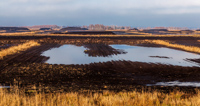What Is The Problem?

Peat bogs are "our rain forest," whose destruction is responsible for at least 5 percent of the global greenhouse gas (GHG) emissions. That is more than all aviation combined. (LINK). Peatlands are the largest terrestrial carbon store, exceeding the capacity of all the world's forests yet occupying only a tenth of the space. Pristine peatlands act as a carbon sink that sucks CO2 from the atmosphere. These landscapes are endangered because of farming, peat extraction, and climate change.
Why Do We Use Peat-Based Potting Soil?
Peat is a lightweight material that stores water well. It's acidic, sterile, and nutrient-poor. Therefore, it's possible to adjust its properties with lime and fertilizer easily.
Peat is also dirt-cheap because the environmental damage of peat extraction is not reflected in its price. At the moment, it's extracted from drained peat bogs. Digging, drying, and transporting are the simple and cheap work steps required to bring this fossil material to the consumers.
The Effects of Peat Extraction
The damage we do to peat bogs has many detrimental environmental effects. We call them the 'Four sins of peat extraction':
- Greenhouse gases. Peat is a fossil material (see our FAQs LINK), which oxidizes when not in a waterlogged state, adding carbon to the atmosphere. The Emissions Trading Scheme (ETS) does not cover peat extraction and oxidation emissions. Therefore, peat is artificially cheap and is a lost chance to set an economic incentive to phase out the use of peat.
- • Loss of biodiversity: Peat bogs are home to many rare species. Read more about this point and whether the RPP certificate (Responsible Produced Peat) can address biodiversity loss. (LINK)
- Loss of the sponge effect: peat bogs mitigate both droughts and floods.
- Land subsidence: we used to extract peat in the Netherlands, one of the main reasons that so much of our country is below sea level. Subsidence is bringing enormous cost and risk- just think of the extra strain on dykes, which already have to be able to withstand rising sea levels.
See the first entry of our FAQs (LINK) for a more comprehensive list of all ten damage categories that peat extraction brings. See also this movie (LINK) on our YouTube channel (LINK) about the damage caused by peat extraction.
Therefore, we need to phase out peat for gardening, ornamental plants, and ultimately, food production, as described in "What's the solution" (LINK). Peat needs to be replaced by more sustainable materials.
A ban is the clearest signal that politics can send to industry and consumers. Voluntary agreements have failed repeatedly in many countries and are often abused as a delaying tactic.